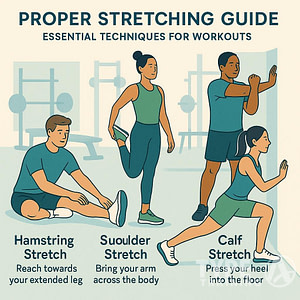Engaging in personal training as a couple offers a unique opportunity to build a stronger bond while pursuing fitness goals together. It’s a chance to spend quality time with your partner in a productive setting, encouraging each other as you both work towards improved health and wellness.
Personal trainers who specialize in couples personal training design workouts that account for both individuals’ fitness levels. This ensures that each session is beneficial and challenging for both partners. By doing so, the experience is more than just a routine exercise; it’s a shared journey towards reaching personal health objectives.
This shared fitness experience not only motivates you and your partner to stay on track but also adds an element of accountability.
Popular posts:
With tailored workout routines, you receive expert guidance that aligns with each of your needs while fostering a spirit of teamwork.
Your personal trainer serves as a resource for both exercise and nutrition advice, customized to suit your collective preferences and goals.
Opting for personal training as a couple does more than just assist in getting you both physically fit. It also introduces an exciting dynamic to your relationship, presenting opportunities to support and push each other’s limits in a safe and structured environment.
Trainers with experience in coaching couples recognize the importance of creating friendly competition and varied physical activities. These can spice up your workout routine and keep both partners engaged and motivated over time.
Whether your shared goal is weight loss, muscle gain, or simply maintaining a healthy lifestyle, couples’ personal training might be the catalyst you need to achieve success together.
Benefits of Couples Personal Training
Engaging in couples personal training offers a unique opportunity to build a stronger bond with your partner while achieving your fitness goals. This shared journey can significantly impact both your relationship and your health.
Strengthening Relationships Through Fitness
Through couples personal training, you and your partner embark on a fitness regimen that can strengthen your relationship. Working out together presents an opportunity for bonding over shared goals and experiences.
It’s a time when you can support each other’s efforts, celebrate successes, and work through challenges, fostering a deeper connection.
Trainers often tailor exercises that encourage teamwork, ensuring that your workouts not only enhance your physical health but also your relational dynamics.
Enhanced Motivation and Accountability
One of the greatest benefits of training with a partner is increased motivation and accountability.
Having someone by your side who shares your fitness goals can provide the necessary encouragement to stay committed.
Shared motivation means you’re less likely to skip workouts, pushing each other to stay on track.
Moreover, when you’re both held accountable for showing up and putting in the effort, it leads to more consistent progress and keeps your mutual commitment to health strong.
Designing a Couples Training Program
When creating a fitness program for couples, it’s vital to assess each partner’s fitness levels and design a regimen that includes a diverse range of workouts to meet individual needs while fostering shared fitness goals.
Assessing Individual Fitness Levels
Before you embark on a couples training program, it’s imperative to individually evaluate your and your partner’s fitness levels.
This assessment can determine strengths, weaknesses, and health concerns that may impact training.
Consider factors like cardiovascular endurance, muscular strength, and flexibility.
To create a personalized workout, use objective measures such as running or cycling stamina tests for cardio, one-rep max tests for strength training, or flexibility assessments for activities like yoga.
Incorporating a Variety of Workouts
Once you’ve established individual fitness benchmarks, aim to incorporate a mix of workouts that address different fitness levels and preferences.
Create customized workouts that include:
- Cardiovascular exercises: Schedule runs, cycling, or boxing sessions that allow you to work out side-by-side or at your own pace.
- Strength training: Design routines with exercises that can be modified in weight and intensity, allowing both partners to challenge themselves according to their strength levels.
- Flexibility and balance: Include yoga or stretching sessions to enhance overall well-being and recovery.
Mixing these elements keeps workouts dynamic and ensures that both you and your partner remain engaged and motivated.
Remember, the aim of the program should be to complement each other’s goals, leading to a healthier lifestyle together.
Building an Effective Workout Routine
Creating an effective workout routine as a couple requires a balance of shared health and fitness goals while accommodating each individual’s schedule. Let’s explore how you can set achievable health goals and manage any potential scheduling conflicts.
Setting and Achieving Health Goals
Firstly, establish specific health and fitness goals together. Whether it’s improving cardiovascular health, gaining muscle, or enhancing flexibility, defining clear objectives will keep you both motivated.
- Identify Shared Goals: Write down goals that align with both of your interests to ensure mutual commitment.
- Create Smaller Milestones: Break larger goals into smaller, quantifiable milestones, making progress more manageable and rewarding.
Remember to reassess these goals periodically to keep them challenging yet attainable.
Managing Scheduling Conflicts
Synchronizing workout schedules can be one of the trickier aspects of a couples’ exercise routine. To prevent scheduling conflicts:
- Regular Planning Sessions: Have weekly discussions to plan your workout times, ensuring they fit comfortably within your individual commitments.
- Flexible Routine: Develop a base program that can be adjusted. If a session is missed, having alternative options for solo or later partner workouts ensures consistency.
By effectively navigating scheduling challenges, you maintain the momentum of your workout routine and support each other’s health journey.
Overcoming Common Challenges
When embarking on a fitness journey together, you will face a number of challenges, such as disparities in fitness levels and injuries. Knowing how to manage these effectively is crucial for a harmonious and effective training experience.
Dealing with Different Fitness Levels and Goals
Acknowledge and Embrace Differences: Fitness is not one-size-fits-all, and your individual capabilities and objectives may differ significantly.
It’s imperative to establish a training program that respects these differences rather than imposes uniform expectations.
A personal trainer can tailor exercises so that each of you is working within your own ability level while still moving towards your personal goals.
- Set Common Goals: While your individual fitness levels may vary, setting shared achievable milestones can create a sense of camaraderie and collective accomplishment.
- Customize Workouts: Your trainer can create a plan that integrates different activities, ensuring you’re both challenged appropriately—this might mean alternating between shared exercises and individual tasks during your workout.
Navigating Injuries and Physical Health Concerns
Stay Informed and Communicate: Your safety is paramount. Being upfront about any injuries or health concerns with your personal trainer is non-negotiable.
An experienced trainer can adjust your workout plan to accommodate limitations and promote recovery without sidelining your fitness journey.
- Employ Modifications: If one of you has a physical limitation, exercises can be modified to reduce stress on the injury while maintaining the intensity level for the uninjured partner.
- Dynamic Adjustments: As your physical health changes, your personal trainer should reassess your workout routine, making dynamic adjustments that align with your current state of health and fitness goals.
The Role of the Personal Trainer
When engaging in couples personal training, the personal trainer takes on a pivotal role, setting the stage for a beneficial and harmoniously challenging experience. Your trainer’s expertise will be fundamental in fostering both your individual and shared fitness goals, ensuring that each session advances your partnership’s strength and flexibility.
Cultivating a Supportive Training Environment
Your personal trainer is tasked with the delicate balance of providing a training space that encourages you both independently and as a unit.
Teamwork is at the core of a supportive training environment. In this space, the trainer will:
- Encourage mutual support and cooperation
- Address any differences in fitness levels
- Create a safe space for both of you to grow and challenge one another
The goal here is to ensure that neither of you feels left behind or overly dominant in the sessions. This allows both of you to benefit from the positive aspects of working out together.
Customized Training and Flexibility
A one-size-fits-all approach does not work in training couples. This is where your personal trainer’s skills in constructing a customized training program come into play. They will:
- Assess each partner’s individual fitness levels
- Develop a plan that caters to each person’s strengths and areas for improvement
- Adapt the program as you both progress to continuously match your evolving needs
This flexibility within the training program helps accommodate the changing dynamics of your shared fitness journey. Consequently, both of you can remain engaged and motivated as you see tangible progress towards your goals.
Maximizing the Personal Training Experience
When engaging in personal training as a couple, the focus should be on maximizing both your physical and relational gains. Optimal usage of resources and effective communication are pillars of a successful fitness journey together.
Cost-Effectiveness and Shared Resources
Shared Resources: Partnering with your significant other for personal training sessions can be a cost-effective move.
By doing so, you can split the cost, making it more affordable than individual sessions. Moreover, you may have access to in-home personal training, which eliminates travel time and expenses.
Cycling classes can be adapted to each of your fitness levels and when done together, can foster a sense of friendly competition and encouragement.
- Equipment Sharing: Utilize body weight exercises that require no additional equipment or share resources like weights and mats.
- Bundled Sessions: Many fitness instructors offer discounted rates for couple sessions.
Building Trust and Communication
Open Communication: It’s crucial to have open dialogues about your goals and limitations. This ensures your personal training experience caters to both your needs and builds trust and strengthens your bond as a couple.
- Goal Alignment: Align your fitness goals and workout plans. If one enjoys the beach, include outdoor runs or calisthenics in your regimen.
- Progress Tracking: Keep track of each other’s achievements. Make sure to celebrate successes and navigate challenges together.
Frequently Asked Questions
Explore these common inquiries to enhance your understanding of couple’s personal training and how it can support your joint fitness journey.
What are the benefits of engaging in personal training as a couple?
Personal training as a couple can lead to enhanced motivation and accountability. You and your partner can support each other, making it more likely you’ll stick with your fitness routine. Shared fitness goals can also strengthen your relationship and provide a unique way to spend time together.
How can couples find personal training services that cater to their joint fitness goals?
You can find personal training services suitable for couples by searching for trainers with experience in couples personal training. Look for trainers who offer customized workout plans that can be adapted to fit both partners’ fitness levels and goals.
What is the typical cost of personal training for couples?
The cost of personal training for couples can vary based on location, the trainer’s expertise, and the length and frequency of the sessions. Packages and discounts for couples often make it a more economical option compared to individual training rates.
What should couples expect during their first personal training session together?
During your first session, expect an assessment of your fitness levels and a discussion of goals. You’ll also have an introductory workout. This initial session helps the trainer develop a tailored program that addresses both partners’ needs and goals. It’s also a chance to communicate your preferences and any concerns with the trainer.
How are personal training programs for couples structured to accommodate different fitness levels?
Personal training programs for couples are structured with exercises that can be adapted to varying fitness levels. Trainers may incorporate circuit training, adjustable resistance exercises, or parallel activities that allow each individual to work at their own pace while still training together.
Are there any considerations couples should be aware of when looking for a personal trainer?
When seeking a personal trainer, couples should find someone who can cater to both partners’ goals and personalities. Compatibility, communication, and a trainer’s understanding of how to balance and integrate each partner’s requirements are key factors in achieving successful outcomes.













